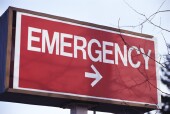
FRIDAY, Feb. 4 (HealthDay News) — A new pediatric study focused on hemorrhagic and ischemic stroke suggests that children who suffer a stroke may experience treatment delays because emergency rooms and paramedics often lack the appropriate tools to diagnose them.
“Stroke in children is rare, but it does exist,” study author Dr. Franz Babl, of Royal Children’s Hospital and Murdoch Children’s Research Institute in Melbourne, Australia, said in a news release.
“Stroke patients in our study had previously been generally healthy, unlike their adult counterparts,” Babl noted. “Because pediatric stroke is so rare, it’s not the first thing we look for. Stroke symptoms in children are frequently attributed to other, more common problems, such as migraine, seizures or encephalitis.”
Babl and his colleagues report their findings in the Feb. 2 online issue of the Annals of Emergency Medicine.
The authors stressed how important it is that stroke symptoms be identified quickly among young patients.
They also noted that earlier pediatric studies on stroke diagnosis have focused primarily on acute ischemic strokes, even though this type of stroke only accounts for half of all childhood strokes. Hemorrhagic strokes accounts for the other half, they said.
In their current medical record review, the team examined 80 young stroke cases and found that most of the children had experienced an immediate onset of symptoms, with 47 suffering an ischemic stroke and 31 a hemorrhagic stroke.
Ischemic stroke was often accompanied by limb and facial weakness, while hemorrhagic stroke was marked by headaches and vomiting.
Yet despite their different presentations, diagnosis by means of computer tomography was not always successful in identifying the type of pediatric stroke at hand: it caught all the cases of hemorrhagic stroke, but only half of the ischemic cases, researchers noted.
A better way of diagnosing the latter, the authors suggested, would be MRI.
“The symptoms and signs of acute ischemic and hemorrhagic stroke are similar in adults and children, but in children stroke is not considered early enough and patients do not receive brain imaging early enough,” said Dr. Babl. “Rapid recognition, response and treatment of children with stroke will start with the development of pediatric brain attack protocols in the emergency department and pre-hospital setting. This study is a first step toward achieving that goal.”
More information
For the more information on pediatric stroke, visit the American Heart Association.

